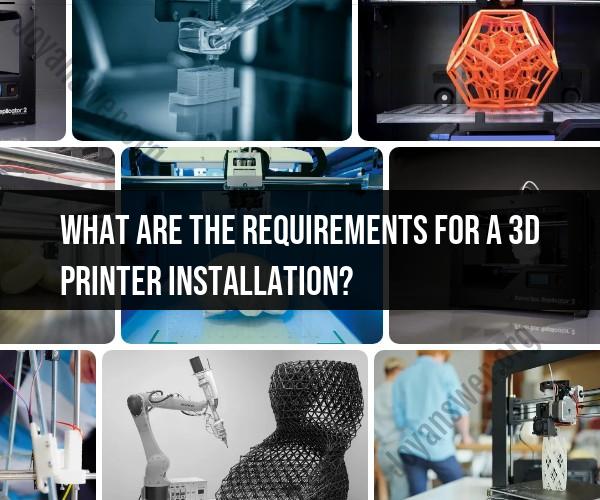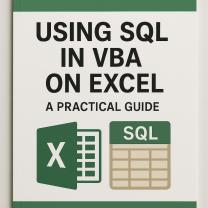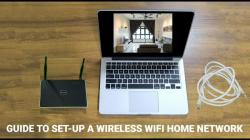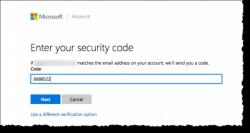What are the requirements for a 3D printer installation?
Installing a 3D printer involves several key requirements to ensure its proper functioning and safety. Here are the essential installation requirements for a 3D printer:
Stable Work Surface: Place the 3D printer on a stable and level work surface, such as a table or workbench. The surface should be sturdy to minimize vibrations during printing.
Power Supply: Ensure access to a reliable power supply with the correct voltage and current requirements for your 3D printer. Most 3D printers operate on standard household voltage (110-120V in North America or 220-240V in other regions). Use a surge protector or uninterruptible power supply (UPS) if possible to protect against power fluctuations.
Ventilation: Provide adequate ventilation in the printing area to disperse fumes and prevent the buildup of heat. Some 3D printing materials emit odors or particles during printing, so consider using a well-ventilated room or a dedicated enclosure with a ventilation system.
Space: Allocate sufficient space around the 3D printer for easy access, maintenance, and cooling. Keep the printer away from obstructions, flammable materials, or sources of heat.
Leveling and Calibration: Properly level the build platform or print bed to ensure that the first layer adheres uniformly to the build surface. Calibration of the printer's settings, including nozzle height and print speed, is essential for achieving accurate prints.
Filament Storage: Store 3D printing filament in a dry and cool environment to prevent moisture absorption, which can affect print quality. Some 3D printers come with filament storage solutions or enclosures.
Filament Compatibility: Ensure that the 3D printer is compatible with the filament materials you plan to use. Different printers may have varying temperature and material compatibility requirements.
Software and Firmware: Install the necessary 3D printing software (e.g., slicing software) on your computer. Keep the printer's firmware up to date to access the latest features and improvements.
Network Connection: If your 3D printer has network connectivity options, such as Wi-Fi or Ethernet, set up the network connection for remote monitoring and control. Some printers also offer cloud-based printing capabilities.
Safety Precautions: Familiarize yourself with safety guidelines and precautions for operating a 3D printer. This includes understanding the risks associated with hot components, moving parts, and high-temperature materials. Always follow manufacturer recommendations for safe use.
Supplies and Accessories: Gather essential supplies, including tools for maintenance, cleaning, and post-processing of prints. You may also need additional accessories like spatulas, adhesives, or build surface materials.
Training and Knowledge: Acquire a good understanding of 3D printing principles, including the printer's user manual and documentation. Consider taking online courses or attending workshops to enhance your 3D printing skills.
Fire Safety: Consider installing fire safety measures, such as smoke detectors and fire extinguishers, in the vicinity of the 3D printer, especially if it will be running unattended for extended periods.
Post-Processing Area: Designate an area for post-processing, which may include removing support structures, sanding, and painting. Ensure proper ventilation and safety precautions in this area as well.
Regular Maintenance: Plan for regular maintenance tasks, such as cleaning the print nozzle, lubricating moving parts, and replacing worn-out components as needed.
By addressing these installation requirements and taking necessary safety precautions, you can set up your 3D printer for successful and safe operation. Always follow the manufacturer's instructions and guidelines to ensure proper installation and usage of your specific 3D printer model.
Essential Requirements for Installing a 3D Printer
Before installing a 3D printer, there are a few essential requirements that you need to meet. These include:
- Space: 3D printers come in a variety of sizes, but they all require some space to operate. Make sure you have enough space in your workspace for the printer, as well as for any necessary accessories, such as filament reels and a print bed.
- Power: 3D printers require a power source. Most 3D printers use standard household power outlets, but some larger or more powerful printers may require a dedicated outlet.
- Ventilation: 3D printers can emit fumes from the heated filament. It is important to have adequate ventilation in your workspace to avoid exposure to these fumes.
- Level surface: 3D printers need to be placed on a level surface to ensure that they print accurately.
- Computer: 3D printers need to be connected to a computer in order to be controlled and to receive print instructions.
Setting Up Your 3D Printer: Installation Requirements
Once you have met the essential requirements, you can begin setting up your 3D printer. Here are the basic steps:
- Unbox the printer and remove all of the packing materials.
- Place the printer on a level surface.
- Connect the printer to a power source.
- Install the filament reel.
- Level the print bed.
- Connect the printer to your computer.
- Install the necessary software on your computer.
- Test the printer.
Steps to Ensure a Successful 3D Printer Installation
Here are a few tips to help you ensure a successful 3D printer installation:
- Follow the manufacturer's instructions carefully. Every 3D printer is different, so it is important to follow the manufacturer's instructions carefully when setting up your printer.
- Take your time. Don't rush the installation process. It is better to take your time and do things correctly than to rush and make a mistake.
- Be careful. 3D printers can have moving parts and hot surfaces, so it is important to be careful when setting up and using your printer.
- Test the printer thoroughly. Once you have set up your printer, be sure to test it thoroughly before starting your first print. This will help to ensure that everything is working properly.
If you have any problems setting up or using your 3D printer, be sure to consult the manufacturer's documentation or contact the manufacturer for support.












